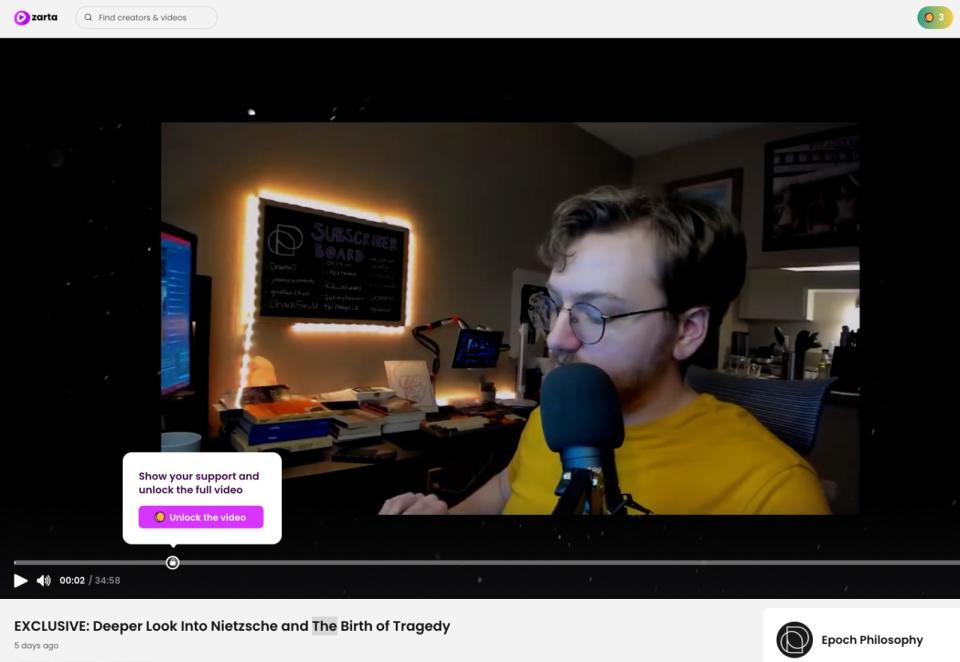Zarta, a creator platform focused on pay-per-view video content, raises $5.7M led by a16z
Zarta, a new ad-free creator platform that focuses on pay-per-view video content, announced today that it has closed a $5.7 million seed round led by Andreessen Horowitz (a16z). The platform allows creators to upload videos, set parameters for a free preview and then charge viewers a small amount to unlock the whole video. Zarta is currently in limited alpha testing with a small set of creators, with plans for a broader launch later this year.
The company was founded in 2021 by YouTube creator and former Airbnb software engineer Luba Yudasina. She told TechCrunch in an interview that a lot of the inspiration behind Zarta came from her own personal journey as a creator. Yudasina wanted to monetize her content in ways other than sponsored brand deals and subscriptions. Although she initially wanted to start a Patreon, Yudasina heard from creators that it can be difficult to continuously pump out exclusive content for a small percentage of your audience, and that it can get expensive for viewers to subscribe to all of their favorite creators.
Yudasina then decided to create Zarta to offer a new way for creators to generate income through microtransactions, while better serving their fans with authentic content. She believes that in the future, good content from creators won’t solely be supported by ads or subscriptions, and that Zarta has the potential to enable this transformation.
Creators on Zata can upload a long-form video and select how much of a free preview they want to give viewers. The company believes that users should be able to preview content before paying for it, and that creators know their content best and can decide when the paywall appears. Viewers can watch as many free previews as they want, but if they want to watch an entire video, they have to pay a small amount of money to unlock the full video. As part of the alpha testing, the cost to watch a full video is less than $1.
Creators receive 75% of the payment, while Zarta keeps 25% to cover operational costs and processing fees. Zarta is committed to giving creators a bigger cut of payments in the future.

Image Credits: Zarta
Once a viewer pays for a video, they can rewatch it at any given time. Users can create a personalized library of content that they conscientiously have decided to consume. The company believes the idea of conscientious media consumption is important, given that the majority of popular apps and services are designed to keep users on their platforms for as long as possible.
“We have the mindset that we’re not going to be a platform for every single creator out there in every single use case,” Yudasina said in an interview. “We’re very focused on creators who are producing valuable content in niches. Think about your favorite car creator or Dungeons and Dragons creator. Folks who aren’t necessarily focused on growing at all costs and likely are not going to be the next MrBeast, but have a strong and loyal community and are producing value for their audience and may not have as many opportunities to monetize as folks that are making a lot of money through AdSense or brand deals. These are the types of creators that we are focused on and want to serve.”
The premise behind Zarta isn’t to get creators to use it as their sole creator platform. Yudasina believes that there will always be a place for companies like YouTube and Patreon, and that Zarta aims to expand the opportunities available to creators. Zarta’s goal is to be a part of the creator ecosystem, as opposed to aiming to replace current players.
Yudasina’s vision for Zarta is demonstrated by creators who are currently testing the platform. Ian Bennett, who runs the Epoch Philosophy channel on YouTube and is currently testing Zarta, told TechCrunch that although YouTube and Twitch are monoliths in the creator industry and do what they do very well, he believes there are clear holes within the industry that Zarta is trying to remedy. He makes some exclusive content on his Patreon, and is using Zarta to bring those videos to people who can’t afford the monthly subscription fee. Since a large portion of his audience consists of students, Bennett says he likes that he is able to present another option for his viewers. Bennett says it’s worth experimenting with the platform’s model and thinks it will be appealing to viewers.

 Yahoo Autos
Yahoo Autos 